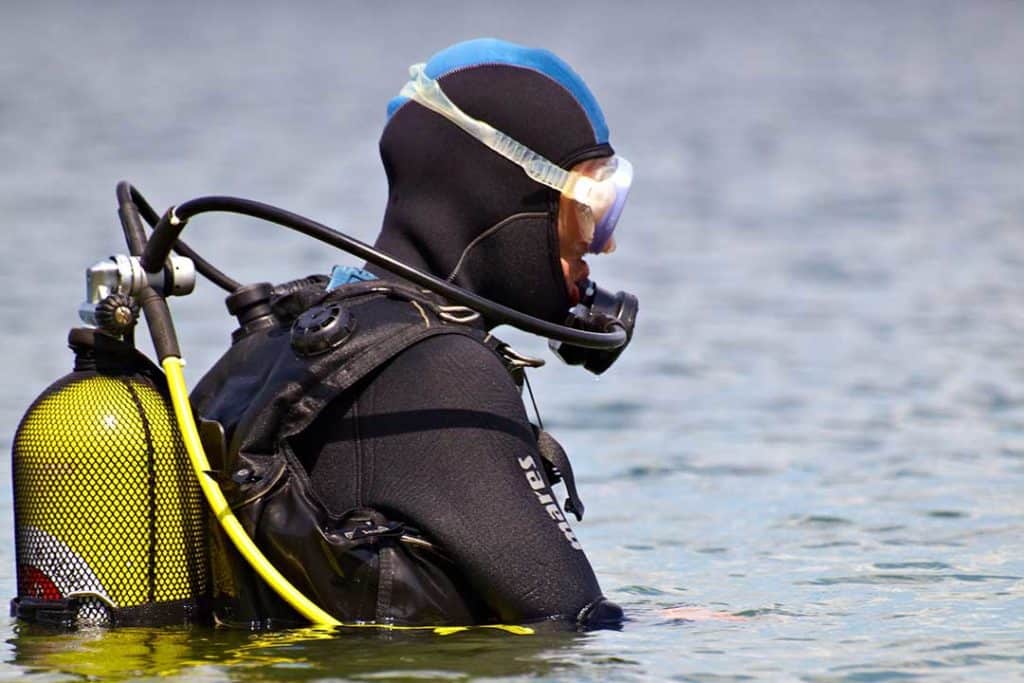Cold water diving is an almost completely independent sport. While the basic skills of scuba diving that one would use in tropical areas are still required, the buoyancy, air consumption, gear requirements, and mental focus needed for cold water diving are completely unique.
For divers looking to delve into a sport of increased focus and skill, cold water diving is the next step!
Before taking the plunge into the cold water, it’s important for a diver to consider the new habits that diving in a new environment will require. Adequate preparation for a cold-water dive will ensure a comfortable and safe diving experience!
Prepare your body by keeping warm prior to the dive

If you’re on your way out to a cold-water dive site, maintain a warm core body temperature as long as possible.
Ensure you’re properly protected topside with warm clothes, eat a hardy meal so your body has calories to burn while cold, and drink warm liquids or take in as much warmth from the sun as possible before your dive.
If you enter the water already cold, it is much more likely you will not be able to participate in the entire dive safely.
It is also helpful to avoid too much caffeine and alcohol leftover in your system before the dive, as those substances will encourage the vasoconstriction of your blood vessels upon entering the cold water (which makes your extremities more numb, and gives you the urge to pee).
Stay hydrated leading up to the dive, with lots of water and electrolytes. This will help your body naturally combat the cold.
Adequately prepare before your dive

Make sure your gear is all prepped and ready before changing into your suit (and only use gear that you know fits properly!) — a quick and seamless entry into the water will help store your body heat as long as possible.
Double check that all your gear is present, working, and properly connected before changing and gearing up to get in.
Once you’re in, give your body time to acclimate. It could be useful to put your face in the water to get over the shock of the cold before you submerge, or clear your mask a few times in shallow water so the cold shock doesn’t surprise you when you may have to clear it at depth.
Have a conservative and specific dive plan

The cold water will be enough of an additional stimulus during your dive, so don’t enter the water with a dive plan that will make things more complicated. Be sure you and your buddy are on the same page before you gear up: make a simple dive plan, have a backup plan in case of surprises, and stick to the plan once you hit the water.
Consider Diving with a Drysuit

While drysuit certification is not required for drysuit diving, learning to use new gear with the supervision of a professional is always safest.
Certification agencies offer courses in drysuit diving that will provide you with professional instruction and guidance on how to adjust your buoyancy in a drysuit.
If you have done less than 50 dives, it is strongly recommended that you experience new skills (like drysuit diving) in the presence of a dive professional.
Alternatively, if you are a seasoned diver and purchase a drysuit, you can practice for a few hours in a pool to get the feeling of your new buoyancy and underwater movement in the suit on your own. Don’t forget to wear your undergarments while you practice — they will affect your buoyancy, too!
Either way, drysuit diving is a major part of branching off into the (underwater) world of cold-water diving. Typically, once divers transition into a drysuit, they wear it every chance they get. It is life-changing to go on a dive and exit the water completely dry!
Research other cold-water gear

Depending on the temperature of the cold-water site you plan to dive, you may require scuba gear that is built to withstand the cold (in addition to a drysuit or thicker wetsuit).
With water that is cooler than 60 degrees fahrenheit, it is likely that you’ll need a special regulator with an environmental seal to prevent freezing, as well as exposure accessories that will keep your core temperature as warm as possible.
If you find yourself to be a gearhead, you may also want to consider technical diving courses. The tec diving world presents a unique outlook on the way divers approach the water, and what gear they use to do it — you’ll be in scuba gear heaven!
Optimize your underwater movement and trim

Contrary to what might seem logical, keeping as still as possible underwater will keep you warmer. Keep your arms tucked close to your core for warmth, and reduce movement as much as possible so you don’t over-expend your energy (released as heat).
Along these same lines, ensuring you are properly weighted (try a steel cylinder!) and have your gear streamlined will decrease drag and save heat energy, as well.
Have warmth ready for after your dive
Once you’ve completed your dive, don’t linger in your wet gear, especially if the topside weather is cold or windy. Quickly remove gear and exposure protection to put on warm clothes, including socks and shoes.
If it’s especially chilly, come prepared with a large supply of warm water. You can put this into a ziplock bag to hold against a particularly cold body part (typically hands, feet, or in your shirt against your chest), or use it for tea/coffee to warm up internally!
Only 7 tips and tricks?
While some of these suggestions may seem simple–or perhaps you hadn’t thought of them–cold water diving is much less daunting when you are prepared to handle it.
With adequate attention to safety and comfort, cold water diving can offer you some of the best experiences of your diving career.


